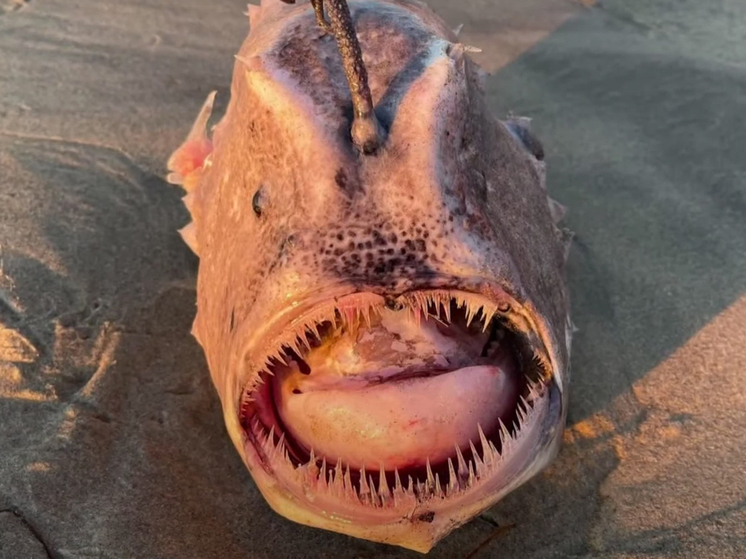An unusual find: People don't often encounter this creature
Two people found something almost never seen on a beach in Oregon — a Pacific football fish. This is one of 200 species of anglerfish around the world, which usually lives in complete darkness in the depths of the sea.

A deep-sea anglerfish (Himantolophus sagamius) was found south of Cannon Beach, a small coastal town in northwestern Oregon, the Seaside Aquarium said in a statement.
Because the fish live deep in the ocean, people have rarely seen them, according to the Seaside Aquarium, which was the first to report the discovery.
“In fact, only 31 specimens have been recorded worldwide,” the State Seaside Aquarium tells Fox News. To date, 32 species of fish are known to have been seen by humans.
In the past, Pacific football fish have been sighted in New Zealand, Japan, Russia and Hawaii, among others.
The Pacific football fish will be left on the beach in accordance with the wishes of those who found it to remain in its natural habitat, The Oregonian's Lizzie Acker reports.
“The person who found it didn't want to give it up us,” aquarium CEO Julia Gomez tells USA Today.
Most people will never see a Pacific anglerfish. These creatures live 600 to a thousand meters below the ocean's surface in almost complete darkness, where they use the light at the ends of their «bulbs» to attract unsuspecting prey using a fishing rod.
“Feeding in the depths The food these guys are looking for can be very scarce, so the fish aren't too picky about what they eat, the aquarium says. “They eat everything that can fit in their mouth.”
The bioluminescent light bulb at the tip of the fish's leg is called an esca. It is filled with photobacteria, which produce light that gives the light bulb its irresistible glow. This contraption is not limited to Pacific football players. It is also used by more than 200 species of angler fish that live deep underwater throughout the world's oceans, including some that live as deep as 2.5 kilometers.
The Pacific football fish that recently washed ashore in Oregon is female. Among angler fish, males and females look and behave completely differently: only females have a characteristic bait on their heads. In addition, they are much larger than males and reach lengths of up to 60 centimeters.
Males are usually ten times smaller. Swimming in the dark, they look for a female that they can attach themselves to like parasites. Once they succeed, they discard their internal organs, eyes and other body parts until only the testicles remain. In this case, the male provides the female with sperm, and the female provides the male with nutrients.
“How males find females in pitch darkness is still unknown,” explains the State Coastal Aquarium.
It's unclear why this Pacific fish washed up on the sand in Oregon or what caused its death. However, the bodies of these deep-sea inhabitants from time to time float to the surface and wash up on shore.
Recall that in October, a lifeguard found a female Pacific football fish on Moro Beach, south of Los Angeles. Another individual washed ashore in the same park in May 2021. Both specimens are now housed at the Los Angeles Museum of Natural History for conservation and scientific research.
Two other Pacific footballfish also stranded in Southern California in 2021—one at Black Beach in San Diego in November and another at Swami's Beach in Encinitas in December.
Already, creatures that have appeared in California in recent years are helping researchers make new scientific discoveries. For example, when scientists viewed Pacific football fish under blue fluorescent light in May 2021, they discovered small green glowing spots on the esk—the first evidence of biofluorescence in a deep-sea anglerfish.
Scientists already knew that the fish's glow lures -anglerfish comes from bioluminescent bacteria. But they didn't know that it is also biofluorescent.
Bioluminescence creates a glow through a chemical reaction. Glow, on the other hand, is a separate phenomenon that occurs when an animal absorbs light at one wavelength and then re-emits that light at a different wavelength.
Many fish have the ability to biofluoresce, but this is an unusual trait for a species that lives in pitch black waters without any lighting. According to researchers, the Pacific football fish may be able to use light from its own escus to create biofluorescence.
It is unclear why this species of fish evolved both bioluminescence and biofluorescence, but scientists believe it could give the creature more an attractive and complex lure to attract prey or mates.
“The combination of bioluminescence and biofluorescence in deep-sea animals is extremely rare, as it has been recorded in only a few species,” says the curator of ichthyology at the Natural History Museum in Los Angeles. Angeles William Ludt. “However, this discovery suggests that this phenomenon may be more common than we think and that it is simply not being studied, since researchers assume that fluorescence does not arise from a lack of light in the ocean depths.”


























































Свежие комментарии